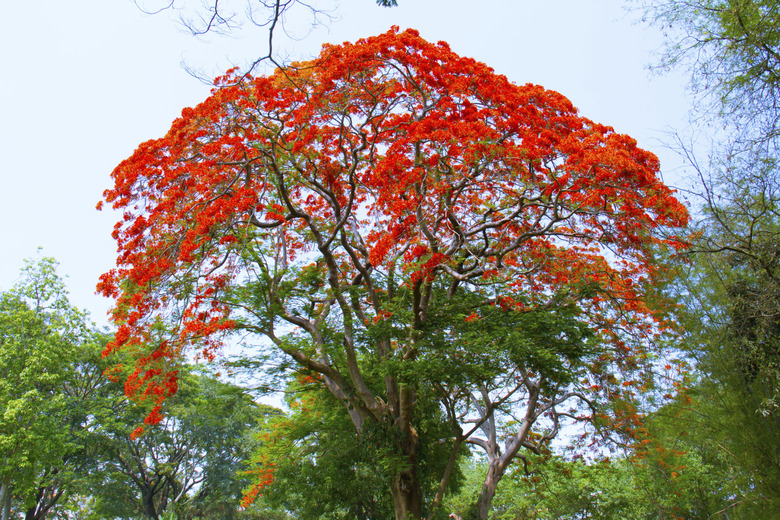How To Care For A Royal Poinciana Tree
Given proper care, royal poinciana (Delonix regia), also known as flamboyant tree, peacock flower, and flame tree, celebrates late spring with color. Flame-red clusters of 5-inch blooms drench the gray-barked branches before their foliage unfurls. Fernlike leaves soon follow on this flowering tree, which can also be grown as a bonsai, and the show continues through midsummer. Long, ornamental seedpods replace blooms by season's end.
The tree reaches 30 to 40 feet tall and spreads 50 or more feet, with its branches forming an umbrella of filtered shade. Hardy in U.S. Department of Agriculture plant hardiness zones 10 through 12, royal poinciana has no serious disease, insect, or other problems when its basic care needs are met. If grown from seed, royal poinciana may take 10 years or longer to bear its first flowers. A tree grown from cuttings may flower in about one-half that time.
How to Care for a Royal Poinciana Tree
1. Choose a Planting Location
Choose the ideal planting location. Royal poinciana's shallow, wide-spreading roots can damage nearby sidewalks, driveways, and foundations. Due to its large size and weak wood, plant royal poinciana trees at least 20 feet from any structures.
2. Remove Vegetation
Remove nearby vegetation that prevents your royal poinciana tree from receiving full-sun exposure. The tree needs a minimum of six to eight hours of direct, full sunlight each day to reach its full potential. Full-sun exposure enhances flowering and improves the canopy's fullness.
3. Water the Tree Regularly
Water a young or recently planted royal poinciana tree's soil regularly. Keep the well-drained soil evenly moist, never soggy, until the tree's roots become established. Native to dry, tropical forests, the drought-tolerant tree needs little more than natural rainfall when mature. Provide supplemental water, if necessary, during the growing season, and reduce water during the tree's winter dormancy.
4. Prune the Tree
Prune the royal poinciana to remove low-hanging limbs and promote strong, healthy branches. The tree grows rapidly, up to 5 feet per year, and weak branches break easily. Use sharp bypass pruning shears for small branches and a sharp pruning saw for larger branches. Sterilize the blades with household disinfectant before and after pruning the tree to prevent the spread of plant diseases.
5. Apply Fertilizer Regularly
Fertilize the royal poinciana four to six weeks after planting it and two to three times per year during its first three years, making the additional applications in early spring and fall. After that, nearby lawn fertilizer or a light, annual compost layer suffices. Broadcast a low-phosphorus, controlled-release, granular, 15-5-15 fertilizer, or a fertilizer with a similar ratio, at a rate of 1 pound of nitrogen per 1,000 square feet of soil surface. For slow-release 15-5-15, that translates to roughly 7 pounds of fertilizer per 1,000 square feet. Water the fertilized area until the fertilizer and soil are thoroughly wet. Water helps fertilizer make good soil contact and begin to work.
6. Rake Below the Tree
Rake the area underneath the flowering tree regularly to clean up broken twigs and seedpods. Winds frequently send weak twigs to the ground. The tree's sculptured surface roots tolerate very little competition, and so the ground stays bare except for tree litter and occasional sprouting seedlings. In frost-free climates, royal poinciana can become invasive. Cleaning up seedpod debris regularly from the ground under the tree helps limit that problem.
7. Keep the Area Below Clear
Avoid planting anything beneath the tree. Royal poinciana's aggressive roots out-compete grass, shrubs, and other plants for moisture and nutrients. Planting in the area beneath the tree's canopy yields poor results because the plants rarely survive.
8. Protect It From Frost
Provide protection from frost. Royal poinciana is a tropical, frost-sensitive plant. If temperatures drop near 45 degrees Fahrenheit, cover a young royal poinciana with a cloth sheet or landscape fabric to protect it from frost damage.
